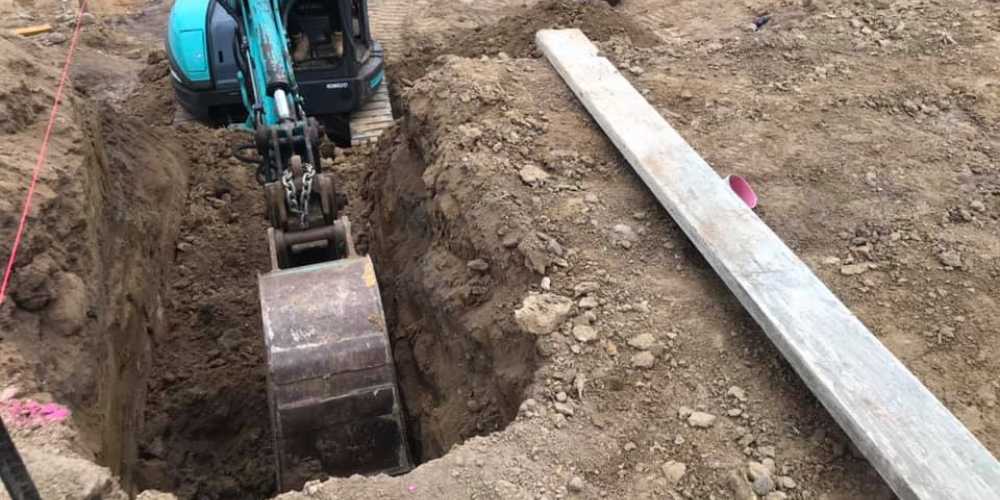Trenching vs Excavation - How Do They Differ?
Removing soil to make a hole in the ground is referred to as excavating and trenching, respectively. Trenching or excavating is the appropriate phase depending on the hole’s size, shape, and depth. Both are challenging, time-consuming, and even dangerous undertakings that need only to be handled by expert earthmovers.
There is a distinction between trenching and excavating, even though they both relate to excavation services that include removing material from the ground to create large, open holes.
Recognising the difference is critical to avoid misunderstandings between your business and the earthmoving companies you’ll be dealing with. The effects could be permanent, but even if they could be fixed, doing so would be expensive. You can ensure your project runs successfully by having a solid grasp of the terminology and how these services operate.
What is Trenching?
Trenching is a method of digging an excavation or trench. It can also refer to a trench built on an existing road to drain water out of it when there are trouble spots, such as wet bridges, soil liquefaction and other unique conditions.
Most soils include a volume of material or an underground soft and unconsolidated layer. This layer can be highly absorbent, allowing the clay to rush through.
The word ‘trenching’ is often associated with construction, especially in the form of earthwork. It’s a process used on the soil to drain water away from an area or create a path for pipes, wires or cables to run through.
Trenching on soil works is a great way to improve the health of your lawn by providing it with nutrients and water. Trenching can also help reduce compaction, which creates wedge pressure on the soil resulting in poor root growth.

Types of Trenching
Excavation
This is the most common type of trenching. Workers dig holes into the ground to uncover buried pipes, cables and other infrastructure. It is also used to install underground heating and electric cables. The excavation depth depends on the size and type of equipment used and local legislation.
Demolition
Demolition involves removing debris from buildings or other structures that have been demolished. It can be used for large-scale demolition projects, such as when a building is demolished for redevelopment or to make way for new roads or railways. Demolition can also large clear land areas after mining operations have been completed, such as when mining companies need to access sites they haven’t visited in years.
Regenerative works (also known as earthworks).
Regenerative works involve digging trenches through existing soil to allow water to infiltrate the ground and rehydrate it so plants can grow in it again after it has been drained off for construction purposes (such as building foundations). Regenerative works are usually done by hand because machines need to get deeper into the ground (although there are some exceptions).
Uses of Trenching
Trenching is used to excavate and lay pipes, cables, and other underground installations. The trenching process involves digging a trench in the ground and laying cable in it. It also helps to protect roads against erosion and other damage.
Trenching is used when large areas need to be removed to build new roads or other structures. This type of excavation is also used when large amounts of dirt need to be removed from an entire property so that it can be reused elsewhere.
Excavation vs Trenching: How Do They Differ?
There are a lot of similarities between excavation and trenching, but there are also some differences. Let’s take a look at them.
- The main difference between excavation and trenching is that the material being removed is more profound than it would be with trenching.
- Trenching involves digging several feet into the ground to create a larger space for the construction. In contrast, excavation only involves removing dirt to access a structure.
- Trenching is a process that excavators use to remove the soil from around a foundation. It involves digging down the ground with large shovels and backhoes, then removing the soil and replacing it with new material.
- Excavation removes large amounts of soil from an area to create room for something new to be built on top of it. Excavations are done using bulldozers, excavators and other heavy equipment. Still, they can also be done by hand with shovels and pickaxes.
Frequently Asked Questions
The Contractor is responsible for clearing and grubbing (if any) topsoil, which primarily consists of loose soil, vegetable and organic matter, drift sand, unsuitable soil, and garbage. This is done by scarifying the excavation sites and sidewalks to a minimum depth of 300 mm below the natural ground level.
Yes, a trencher will function on damp ground, but exercise caution. You risk losing the chain or wheel if the ground is too damp. However, trenching can proceed more quickly if the earth is only lightly moist.
Depending on several variables, such as bucket capacity, kind of ground, operator skill and efficiency level, an excavator may be utilised to dig anywhere between 350 and 1,000 cubic yards daily.
Trenchers can be used to cut plant and tree roots during lot clearing operations, by landscapers, and by lawn care specialists. Some trencher models come with an integrated blade explicitly made for cutting roots.
Key Takeaways
The words ‘excavation’ and ‘trenching’ are often used interchangeably, but there is a distinct difference in reality. Excavation means digging, so trenching is what you would use to dig a trench. However, the two are not related to one another; that is why we’ve listed them together.
There are many ways to dig, but two of the most common methods are trenching and excavation. Both approaches can be utilised on various projects and should be considered during planning. Like trenching, excavation involves making a large hole in the ground to reach the more valuable soil underneath. However, this soil is dug up from the sides of the hole rather than from within it.


